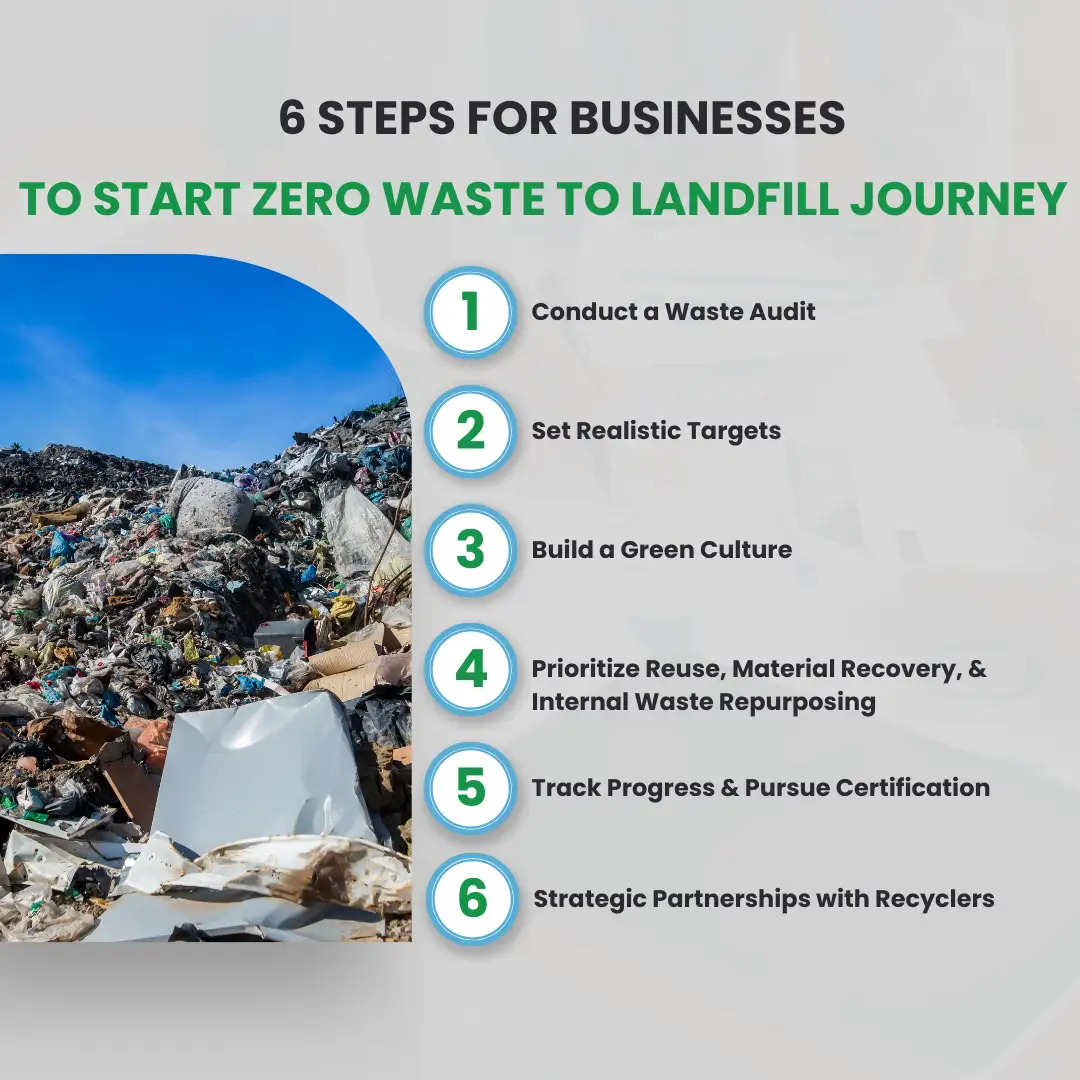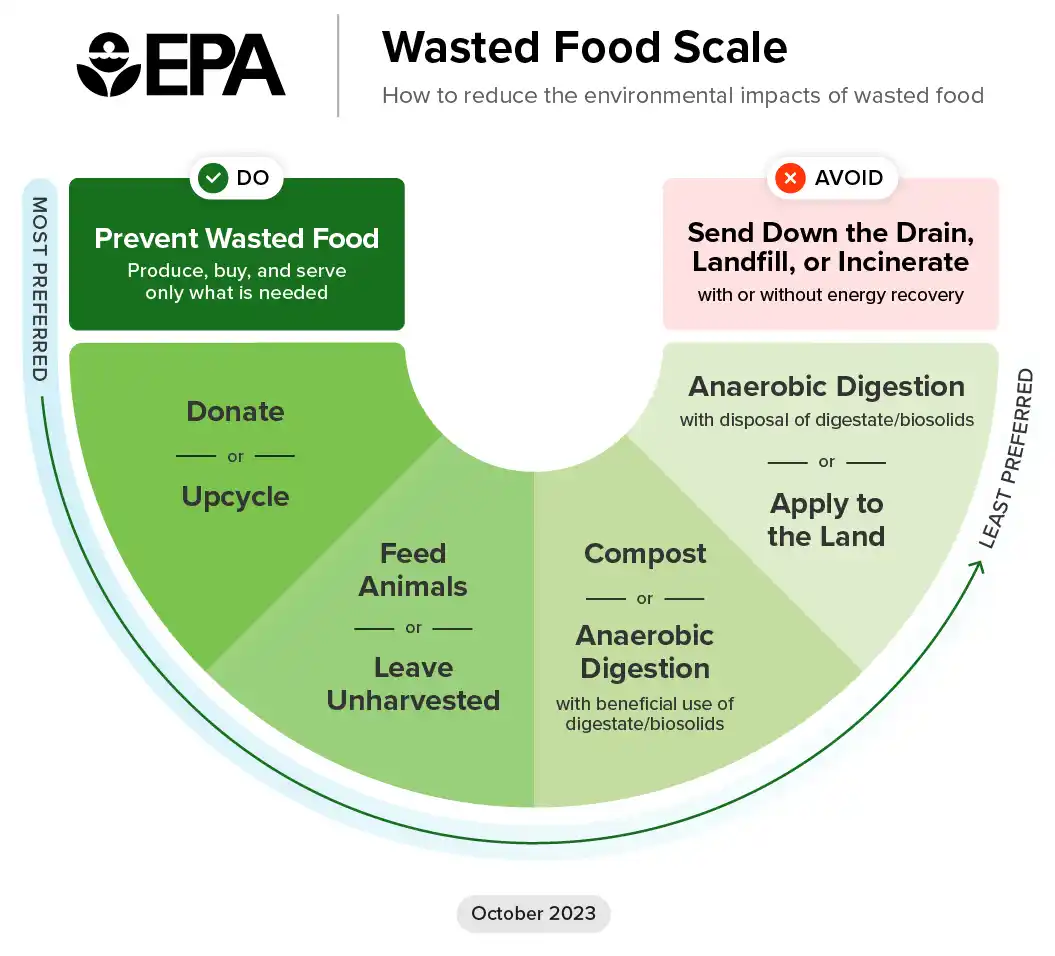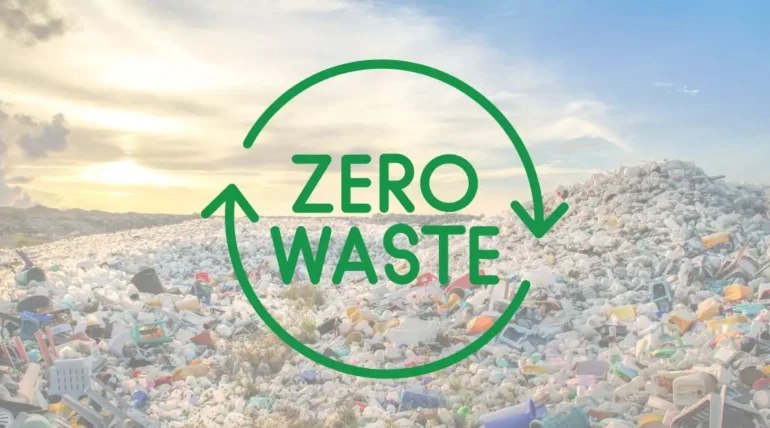Zero waste to landfill—an approach focused on diverting as much waste as possible from landfills—is key to decreasing soil and water contamination, reducing greenhouse gas emissions, and complying with evolving waste legislation and sustainability benchmarks.
With global waste expected to grow to 3.4 billion tons by 2050, implementing zero waste to landfill is no longer optional; it’s essential for long-term sustainability.
How can you get involved?
By adopting sustainable waste management practices for both food waste and other types of waste.
Keep reading to learn the importance of zero-waste disposal for businesses, tips for starting your journey, and everything else you need to reach your goal.
Key Takeaways
- Zero waste to landfill is a waste management strategy aimed at reducing the amount of waste an organization sends to landfills.
- Companies that implement efficient zero landfill waste management can reduce greenhouse gas emissions, minimize pollution, conserve resources, and ultimately protect the environment.
- Businesses that divert waste from landfills can lower landfill fees, avoid regulatory fines, and reduce the overall cost of materials through improved efficiency and waste minimization strategies.
- By raising awareness about the importance of waste reduction, training employees on new approaches, and aligning environmental initiatives with your company’s strategy, you can integrate sustainability into the core of your organization’s operations and values.
What Does ‘Zero Waste to Landfill’ Actually Mean?
Zero waste to landfill is a waste management strategy aimed at reducing the amount of waste an organization sends to landfills. As we’ll discuss in more detail below, there are various zero waste-to-landfill strategies that businesses can implement to achieve their waste reduction goal, such as reducing waste at the source, investing in recycling infrastructure, and composting organic waste.
The Differences Between “Zero Waste” vs. “Zero Waste to Landfill”
When we hear “zero waste,” it’s easy to assume it means producing no waste at all. And while this is ideal, it’s not the reality for many companies or communities.
Instead, zero waste to landfill aims to divert as much waste as possible away from landfill sites through responsible strategies, such as reuse, recycling, and composting.
Take New York City, for example, which is celebrated for its goal to reach zero waste by 2030. However, this doesn’t mean they will produce zero waste. Initiatives like the Zero Waste Challenge demonstrate a practical approach—targeting a 90% reduction in commercial waste disposal by 2030.
In other words, you don’t have to be perfect; if you’re wondering how to achieve zero waste, the key is to focus on intentional, systematic efforts to manage waste sustainably. Setting realistic, measurable milestones is the first step toward full-scale environmental responsibility.
The Purpose of Zero Waste to Landfill
Below, we discuss in more detail the importance of zero waste to landfill. However, here’s a quick look at why it’s so important:
In 2016, solid waste treatment and disposal produced about 1.6 billion tons of CO₂-equivalent emissions, mainly from open dumps and landfills without gas collection. Without sector improvements, annual emissions could rise to 2.38 billion tons by 2050.
All things considered, sending less waste to landfills should be a key goal for businesses, communities, and governments alike. By increasing landfill sustainability, we can minimize environmental harm, cut greenhouse gas emissions, and promote resource efficiency—ultimately fostering a cleaner, healthier, and more sustainable future.
Why Businesses Should Strive for Zero Waste to Landfill
Since implementing new strategies requires company-wide changes, many businesses want to know what they can gain from zero waste to landfill initiatives.

Keep reading to find out:
1. Environmental Incentives
Reducing landfill waste has an array of environmental benefits.
Perhaps the most important is its role in reducing greenhouse gas emissions. With municipal solid waste landfills being the third-largest source of human-related methane emissions in the U.S., zero waste to landfill helps slow global warming and improve air quality.
In addition, companies that implement efficient zero landfill waste management can minimize pollution, conserve resources, and ultimately protect the environment.
2. Economic Benefits
Did you know that implementing zero waste to landfill has financial incentives as well?
Companies that divert waste from landfills can lower landfill fees, avoid regulatory fines, and reduce the overall cost of materials through improved efficiency and waste minimization strategies. In other words, they can save money while saving the environment.
Even more, companies that foster a culture of circular economy can generate new revenue streams, such as selling repurposed materials like compost.
3. Reputation & Trust
Companies that prioritize sustainable landfill practices demonstrate strong corporate social responsibility and can better meet environmental, social, and governance benchmarks.
There are multiple ways to measure a company’s progress, with the landfill waste diversion rate being a key indicator of recycling efforts. If your business has a high diversion rate, you can improve brand perception and attract eco-conscious partners and consumers, thereby supporting long-term growth.
Overall, striving for zero waste to landfill is a smart, forward-looking business strategy that supports long-term resilience and sustainable growth.
Guide for Companies to Start Their Zero Waste to Landfill Journey
Zero waste to landfill doesn’t happen overnight; it’s a gradual process that takes time and careful planning.
That said, anyone wondering how to reduce landfill waste should consider the following tips:
1. Conduct a Waste Audit
Not sure where to start on your zero waste to landfill journey?
A food waste audit is a great starting point, as it helps you identify waste sources and quantities. Based on your findings, you can create targeted waste prevention strategies that help you achieve sustainability goals.
For instance, let’s say your waste audit shows that large quantities of food scraps are being generated during processing. Instead of discarding these scraps, you can focus on prevention and implement a composting program to divert waste from landfills.
2. Set Realistic Targets
Every company should set a realistic target that matches their short- and long-term goals. For example, rather than saying, “We want to reduce waste by 100% over the next two months,” you may say, “We’re going to implement a composting program to reduce waste by 90% over the next 5 years, with a goal of reducing waste by 18% each year.”
It’s important to note that what works for one company may look entirely different for another. For that reason, you must decide which strategies to implement and set milestones to make your long-term waste reduction target more achievable.
3. Build a Green Culture
While there are many strategies to reduce waste, there’s one approach that shouldn’t be overlooked: building a culture of sustainability.
By raising awareness about the importance of waste reduction, training employees on new approaches, and aligning environmental initiatives with your company’s strategy, you can integrate sustainability into the core of your organization’s operations and values.
4. Prioritize Reuse, Material Recovery, and Internal Waste Repurposing
There are many materials that can be reused rather than discarded.
As explained by the United Nations Development Programme, “In a circular economy, electronic goods are refurbished, water-soluble, recyclable and truly biodegradable packaging becomes the norm, and animal waste is used as natural fertilizers and processed into biogas for cooking, heating and lighting.”
While these are just some examples of how materials can be reused, company leaders should ask themselves: What can we reuse? How can we repurpose materials to extend their value and reduce waste?
5. Track Progress and Pursue Certification
Your company should be tracking the progress of your waste reduction initiative. You can do this by performing waste audits regularly, as you can compare results over time to identify trends, measure the effectiveness of your strategies, and make data-driven adjustments to improve outcomes.
And if you want to take your efforts to the next level, you can pursue a zero waste certificate to demonstrate your commitment to reducing waste and promoting sustainability.
6. Strategic Partnerships with Recyclers
Zero landfill waste management is complex; you must choose the right approach, coordinate transportation, and ensure compliance to avoid fines.
However, you don’t have to manage this alone; there are experienced waste management professionals like Shapiro who can guide you through the entire process. By making these partnerships, you can reduce your environmental footprint and achieve waste reduction targets without having to worry about the complexities of waste management.
How to Achieve Zero Waste? Practical Strategies for Businesses
If you’re worried about achieving cost-effective and sustainable zero waste disposal, these tips are for you:
1. Reduce Waste at the Source
The top priority for businesses should be reducing waste at the source. In fact, the food waste management hierarchy, which ranks actions to prevent and divert wasted food, identifies waste prevention as the most effective method for minimizing environmental impact.
This scale ranks each tier from the most preferred option to the least, as shown below:

That said, reducing waste throughout the supply chain can be accomplished by redesigning products, optimizing inventory management, recycling materials, and many other strategies that improve efficiency. For example, organizations focused on food waste in landfill diversion can enhance demand forecasting, donate edible surplus food, and compost food scraps to reduce environmental impact.
2. Standardize Reuse Systems
Reusing materials shouldn’t be an occasional practice—it should be part of a standardized, efficient reuse system. But how can you set this up?
You should start by identifying which materials are most often discarded and establishing quality standards for what can be reused. You can also set up clearly labeled collection points, train staff on proper handling, and track the amount of materials successfully reused to measure your impact.
3. Invest in Recycling Infrastructure
To properly (and safely) recycle waste, companies require collection systems, storage facilities, on-site processing equipment, and, when necessary, reliable transportation to move materials to processing sites.
And since every type of waste requires a different strategy—for instance, chemical waste disposal is very different from organic waste management—this can be challenging, leading many companies to work with a waste management provider rather than make the investment themselves.
However, each company must consider their resources and operational capabilities before deciding whether to build in-house recycling infrastructure or rely on external waste management services.
4. Explore Composting for Organic Waste
A great strategy for addressing commercial food waste disposal is composting. Not only is composting for businesses a cost-effective solution, but it also reduces your company’s carbon footprint, promotes sustainability, and reduces the amount of waste sent to landfills.
The hidden benefit?
The nutrient-rich compost produced can be sold, turning waste into a potential revenue stream while supporting local agriculture and landscaping needs.
5. Partner with Certified Recycling and Recovery Specialists
As mentioned, you don’t have to handle waste management alone; there are certified recycling and recovery specialists that can help you through every stage of your zero waste to landfill journey.
At Shapiro, we help you understand the ins and outs of waste management, answering questions like: What is landfill diversion? How can I achieve landfill sustainability?
These partnerships provide the expertise, resources, and guidance needed to achieve long-term waste reduction goals.
Conclusion
Companies that implement zero waste to landfill initiatives can significantly reduce their environmental impact while improving operational efficiency and brand reputation.
At Shapiro, we partner with businesses to develop tailored strategies, provide expert guidance, and deliver practical solutions that make achieving zero waste to landfill both attainable and sustainable.
Whether you’re interested in composting, turning food waste to energy, or implementing another waste management strategy, our services are customized to fit the unique needs of your business.
Contact us today to explore our services.
FAQs
With a proper plan and a strong commitment to sustainability, achieving zero waste to landfill is possible for companies across industries. That said, the goal of this approach is to keep as much waste as possible out of landfills, since expecting to produce absolutely no waste at all is not realistic.
The time it takes to achieve zero waste to landfill varies widely, typically ranging from a few years to over a decade, depending on a company’s size, industry, resources, and commitment.
No, you do not require certification. That said, certifications show your company’s commitment to zero waste, helping you stand out as a leader in sustainability.
Artificial intelligence and sensors are enabling more efficient waste sorting systems, real-time waste tracking and analytics, automatic inventory management, more advanced waste management systems, and more.
Recycling, composting, and anaerobic digestion all reduce reliance on landfills and support a comprehensive zero waste to landfill strategy.
Baily Ramsey, an accomplished marketing specialist, brings a unique blend of anthropological insight and marketing finesse to the digital landscape. Specializing in educational content creation, she creates content for various industries, with a particular interest in environmental initiatives.



